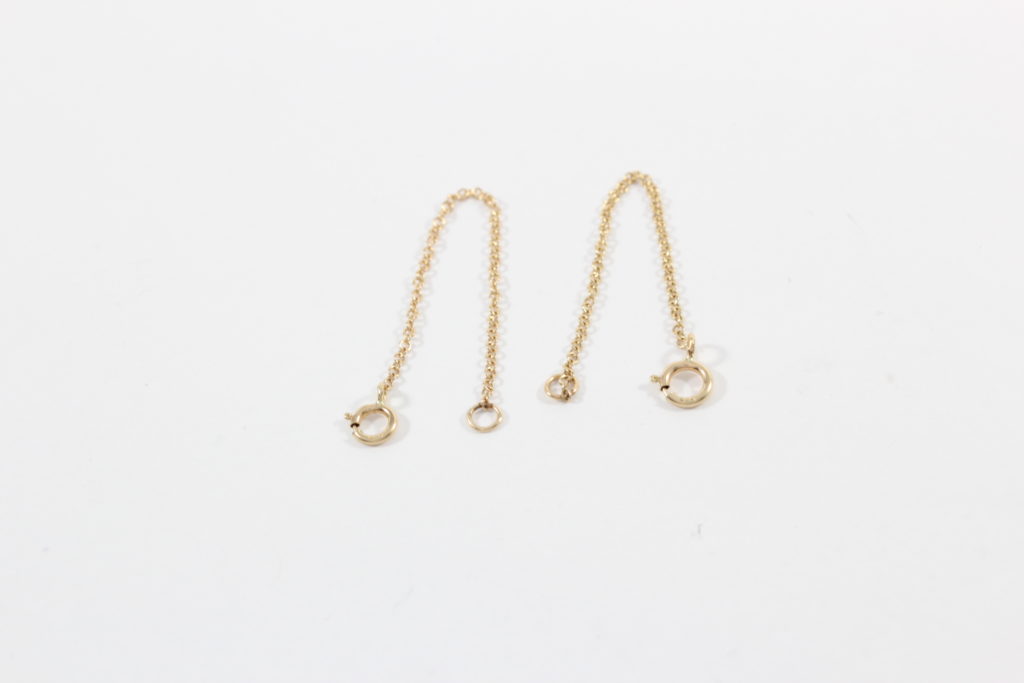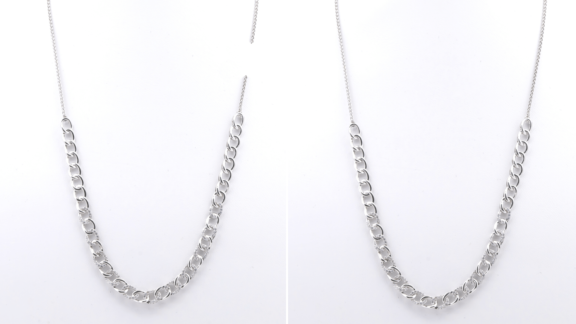How To Repair A Necklace Clasp
Necklaces and bracelets accept to be fastened on somehow- and the mechanism that does all of the work is the clasp! But clasps come in many unlike designs, just like the pieces of jewelry. Some are more than convenient and like shooting fish in a barrel to work with, while others are elaborate and complicated. Go on reading to learn more about different jewelry clasp types and what all-time suits your needs.
Jewelry Clasp Types
1. Spring Ring Squeeze

These bits of gold concatenation accept attached jump ring clasps.
The most common and classic one out of all the jewelry clasp types, a spring band clasp consists of a little wire tucked inside a hollow hoop. When you pull the tiny lever backwards, information technology moves the wire into the hoop, leaving backside an empty gap so you can claw the other stop of the chain into the clasp. Releasing the lever allows the wire to spring back, securing the piece of jewelry. The design is discreet, making it an splendid choice for thin and delicate necklaces.
When a spring ring clasp is broken, the jeweler can either repair it or supplant it. The nearly common repair is bending the piffling wire back into the hoop, when a bad tug pulls information technology out. If the entire hoop has been crushed, the jeweler replaces information technology, as at that place is no way to prepare the harm.
two. Lobster Clasp

This gold concatenation necklace is fastened with a lobster clasp.
Lobster clasps resemble the claw of a lobster, hence the name. Compared to a spring band squeeze, they're a petty stronger and sturdier, since the mechanism is made out of a thicker piece of metal. Pressing down on the lever causes the bottom part to move inside, leaving behind a space for the other end of the chain. Lobster clasps are not every bit dainty as jump rings, just they are suitable for heavier chains, bigger necklaces, or necklaces with pendants since they tin support the weight.
While non as common as the spring ring repair, the little bottom part is besides prone to existence pried out from wear. With a pair of pliers, the jeweler can bend information technology back into shape. On occasion, the lever may go stuck, and the repair for that kind of damage is variable- sometimes the jeweler will not be able to set it, requiring a replacement.
3. Toggle Squeeze

This gilded chain bracelet has a jeweled toggle clasp.
The toggle squeeze is markedly different from the lobster and the spring ring clasps in design. A thick hoop and a long bar are attached to opposite ends of the concatenation, and the long bar is vertically tucked through the hoop. One time it's through, the horizontal orientation of the bar prevents information technology from slipping out of the hoop, locking the chain.
This clasp is very stylish and is commonly used for bracelets, where it is more visible. The just downside is that information technology'southward prone to unlocking itself, since the but thing that keeps a toggle squeeze close is the bar, which must stay horizontally-aligned against the hoop.
Information technology's rare to see a toggle clasp damaged, since the components are commonly solid and quite tough. However, the blueprint of the toggle clasp may bear on this; if at that place are stones in the toggle squeeze, they may need resetting or replacement over time.
iv. Box Clasp

This gold rope chain was inverse from a lobster clasp to a box clasp.
Box clasps are commonly used for elegant pieces, such as diamond tennis bracelets. The clasp is made out of 2 parts; a small-scale, apartment piece, and a hollow box. The piece fits into the box part, and an additional little latch on the outside is clipped over the opening in social club to make sure the jewelry is secure. While they look dainty and decorative, they cannot support a substantial amount of weight and should not be used for very heavy necklaces.
In terms of repairs, the box squeeze has a lot of issues. Its blueprint means that it gets stuck easily, and forcefully tugging it open damages the clasp. The little safety latch on the outside is very sparse and bends or snaps off easily. The jeweler can set up these problems either past loosening the flat component, angle the safe latch back into shape, or replacing the entire clasp.
5. Bolo Squeeze

An evil eye bracelet with a bolo clasp.
The fifth type of clasp is most commonly seen on bracelets. Unlike the other clasps, the bolo is designed to be adjustable; its sliding mechanism allows for the wearer to change the size of their jewelry. The two ends of a chain are drawn through the bolo, and moving the bolo up and downwards shortens and lengthens the piece.
While the clasp itself is very sturdy, items that have thinner bondage are prone to breaking from pulling the bolo. It also has the undesirable effect of leaving pieces of concatenation dangling from the bolo itself when adapted to a smaller size.
Since the bolo itself is simply the bead that holds the two chains together, most bug with the bolo clasp accept to practise with cleaved bondage. The jeweler repairs this by soldering the concatenation and making it 1 piece over again before threading it dorsum through the bolo.
With this cursory breakup of jewelry squeeze types, you lot should at present have a better sense of what would work best for your jewelry! If you're looking to fix one of the higher up, or swap to a new clasp, get started with our featured services below.
Featured Services:
-

-
Source: https://quickjewelryrepairs.com/articles/5-popular-jewelry-clasp-types-and-how-to-repair-them/


0 Response to "How To Repair A Necklace Clasp"
Post a Comment